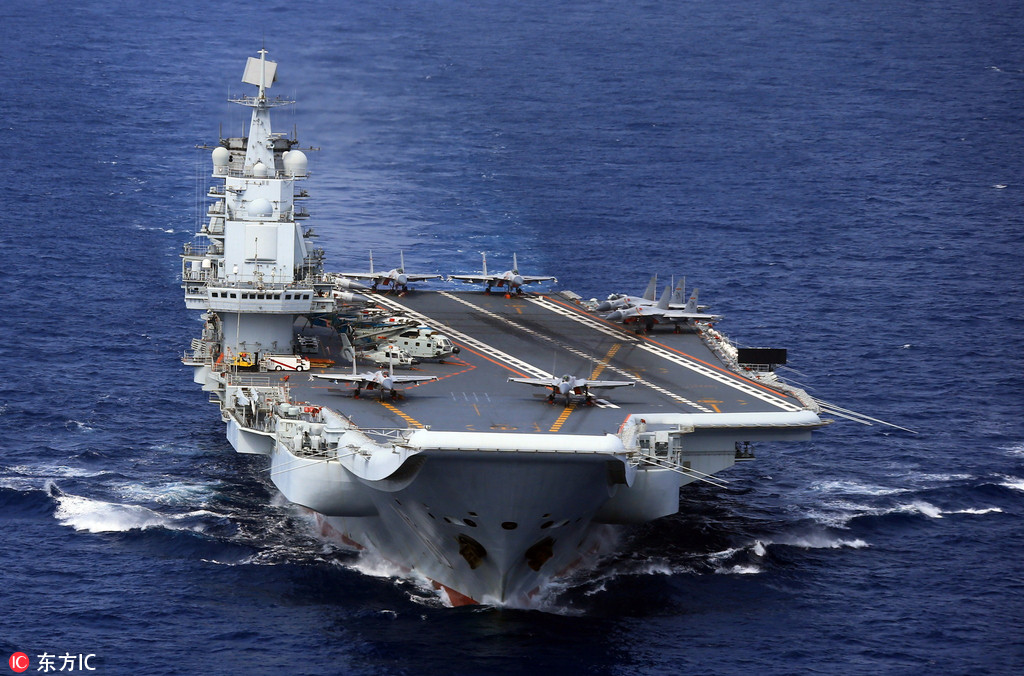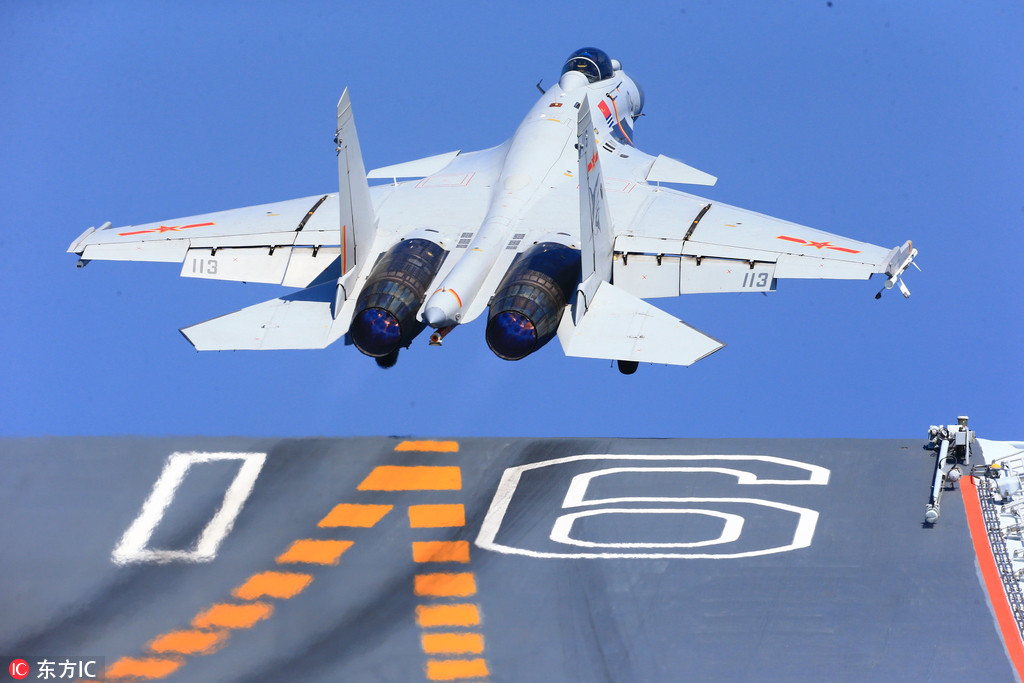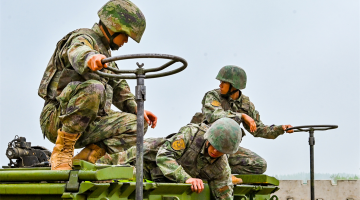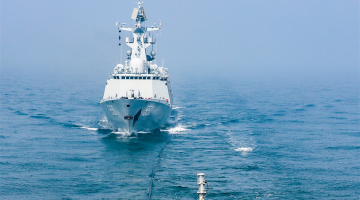
A year since an inspection by President Xi Jinping, also chairman of the Central Military Commission, the People's Liberation Army Navy has made massive strides in transforming itself into a world-class force, experts said.
In the past 12 months, the Navy has conducted a number of warfare drills in open seas, taken part in bilateral or international naval exercises, made several overseas visits and established the nation's first overseas support base.
It has also commissioned or tested new advanced hardware and invested heavily in research and development in cutting-edge technologies in order to follow Xi's instructions to boost the Navy's overall capability and joint operation ability and make full use of innovation in science and technology.
Wu Peixin, a military observer in Beijing, said the Navy's growth over the past year has been "obvious", and the force has been open and transparent in making its development public.
"It has commissioned many new weapons and equipment, some among the best in the world," he said, adding that the nation now has a better ability to protect its overseas interests thanks to the increasing naval prowess.
On May 24, 2017, Xi, also general secretary of the Communist Party of China Central Committee, visited PLA Navy headquarters in Beijing. He said the Navy should continue to speed up its transformation into a world-class force, ordering all Navy commanders to honor their mission of building a modern, strong navy.
Xi said the Navy's development is strategically important and crucial to national interests and security. He asked the Navy to focus on strengthening its combat capability and carrying out joint operation exercises in line with modern naval warfare. He demanded that the Navy use systematic thinking in making development plans.
Innovation in science and technology must be used to inject momentum into the Navy's sustainable growth, he said during the inspection a year ago.

Continued attention
Xi's attention on the Navy can be traced to his first days as the Party's top leader in late 2012.
On Dec 8, 2012, less than a month after Xi was elected top leader of the Party and the military, he boarded a destroyer that took him to the South China Sea. It was his first inspection of a PLA unit as Central Military Commission chairman.
In the next nine months, Xi made two visits to Navy units, boarding new naval vessels such as a new-generation nuclear-powered submarine and the aircraft carrier CNS Liaoning.
In his latest speech on the Navy, given at a grand sea parade last month, Xi reiterated that the Navy must race against time and spare no efforts to become a world-class force because the country needs a strong navy, stressing that it is an essential pillar to the great rejuvenation of the Chinese nation.
Addressing over 10,000 Navy personnel from a giant combat ship in the parade, Xi asked members of the service to uphold the Party's leadership, deepen military reform, enhance innovation in science and technology, develop new types of fighting forces, build modern naval warfare systems and improve the capability to undertake diversified military operations.
Xi ordered the Navy to continue to focus on combat training and stay on high alert to safeguard the national interests and make more contributions to the peace and stability of the region and the world.

Intensified training
In the past year, the Navy has striven to fulfill Xi's instructions by intensifying military drills and going deeper into blue water.
In April, the Navy carried out its largest parade in the South China Sea, involving a vast armada of 48 ships, including the Liaoning, and six nuclear-powered submarines as well as 76 naval aircraft. The parade, viewed by Xi, displayed the latest achievements in the Navy's modernization drive.
Since May 2017, the Liaoning carrier battle group, a symbol of China's rising prowess at sea, has undertaken two long-range combat exercises, aiming to verify and enhance the collaboration and coordination among ships in the group and between ships and carrier-borne aircraft.
"Such operations have examined the battle group's offensive and defense systems and fostered commanders' ability to make decisions under complicated circumstances," said Gao Zhaorui, chief of staff of the carrier battle group.
Ding Yang, a J-15 carrier-borne fighter jet pilot, said that combat training over open seas hones aviators' response capabilities and supports crew preparedness and commander skills.
In March, two PLA Marine Corps forces, totaling over 10,000 personnel, traveled about 2,000 kilometers to Yunnan and Shandong provinces in a long-range mobility exercise, which military observers called the corps' largest training operation.
In July, China established the Djibouti Logistics Support Base, the nation's first of its kind. The base, managed by the Navy, is tasked with supporting naval escort, peacekeeping operations and humanitarian missions in Africa and western Asia. Navy personnel stationed there have conducted several live-fire drills.
The Navy has also been active in conveying China's goodwill to other nations in the past year. A three-ship fleet made a 176-day voyage to 20 countries in Asia, Africa and Europe from late April to mid-October, setting a record for the Navy.
Chinese naval flotillas also participated in multiple international drills in the Pacific Ocean and executed live-fire exercises in the Mediterranean and Baltic seas during joint exercises.
Improved arsenal
In the past year, the Navy commissioned the nation's largest supply vessel-the first Type 901 class comprehensive resupply ship-enabling the Liaoning carrier battle group to sail farther away. Military observers said the ship displaces more than 45,000 metric tons, making it almost two times heavier than the Type 903 class, now the pillar of the Navy's supply force.
The country's first domestically designed aircraft carrier, launched in April 2017, completed its maiden sea trial last week.
The ship, the largest and most sophisticated naval vessel in China, displaces at least 50,000 metric tons and has stronger fighting capabilities than the Liaoning. Analysts anticipated that it will be delivered to the Navy within a year if sea trials are successful.
The Navy is expecting delivery of a 10,000-ton guided-missile destroyer, widely believed to be the mightiest of its kind in the world. The first in the Type 055 class, the destroyer carries over 100 vertical launch cells capable of firing air-defense, missile-intercepting, anti-ship and anti-submarine missiles. Several Type 055 ships are under construction, and the first is expected to soon begin its first sea trial, according to media reports.
Navy researchers also have developed electromagnetic launch technologies that give Navy ships a futuristic, game-changing weapon-an electromagnetic railgun. Experts say the weapon is capable of revolutionizing future naval warfare with power, range and speed far superior to explosive-powered guns.









